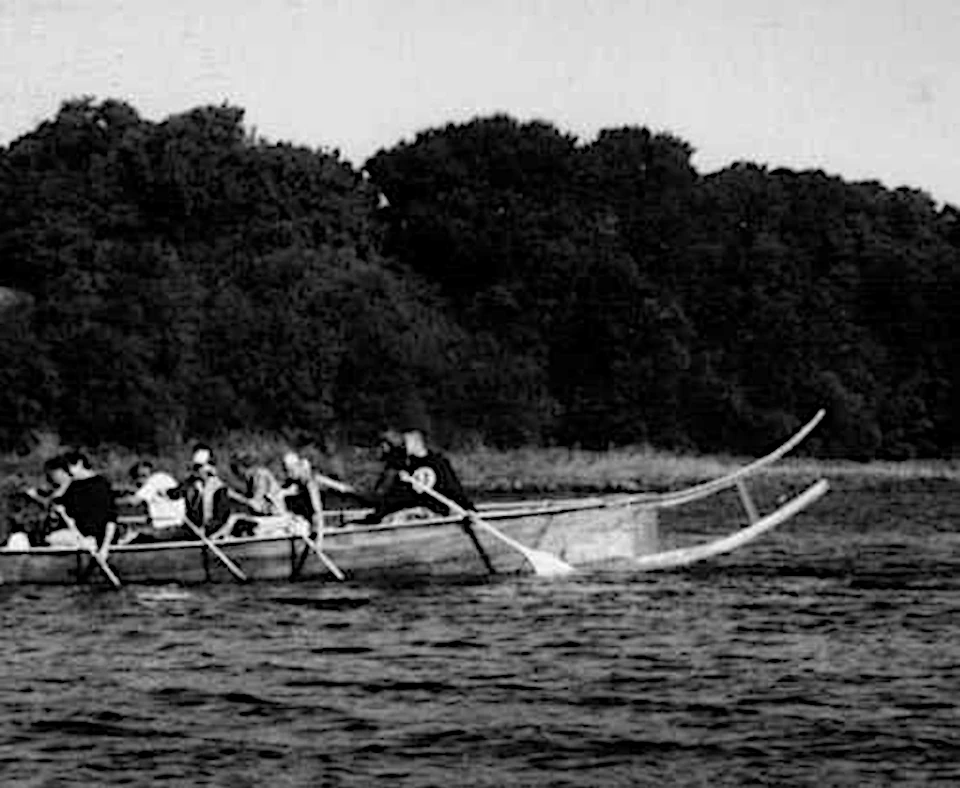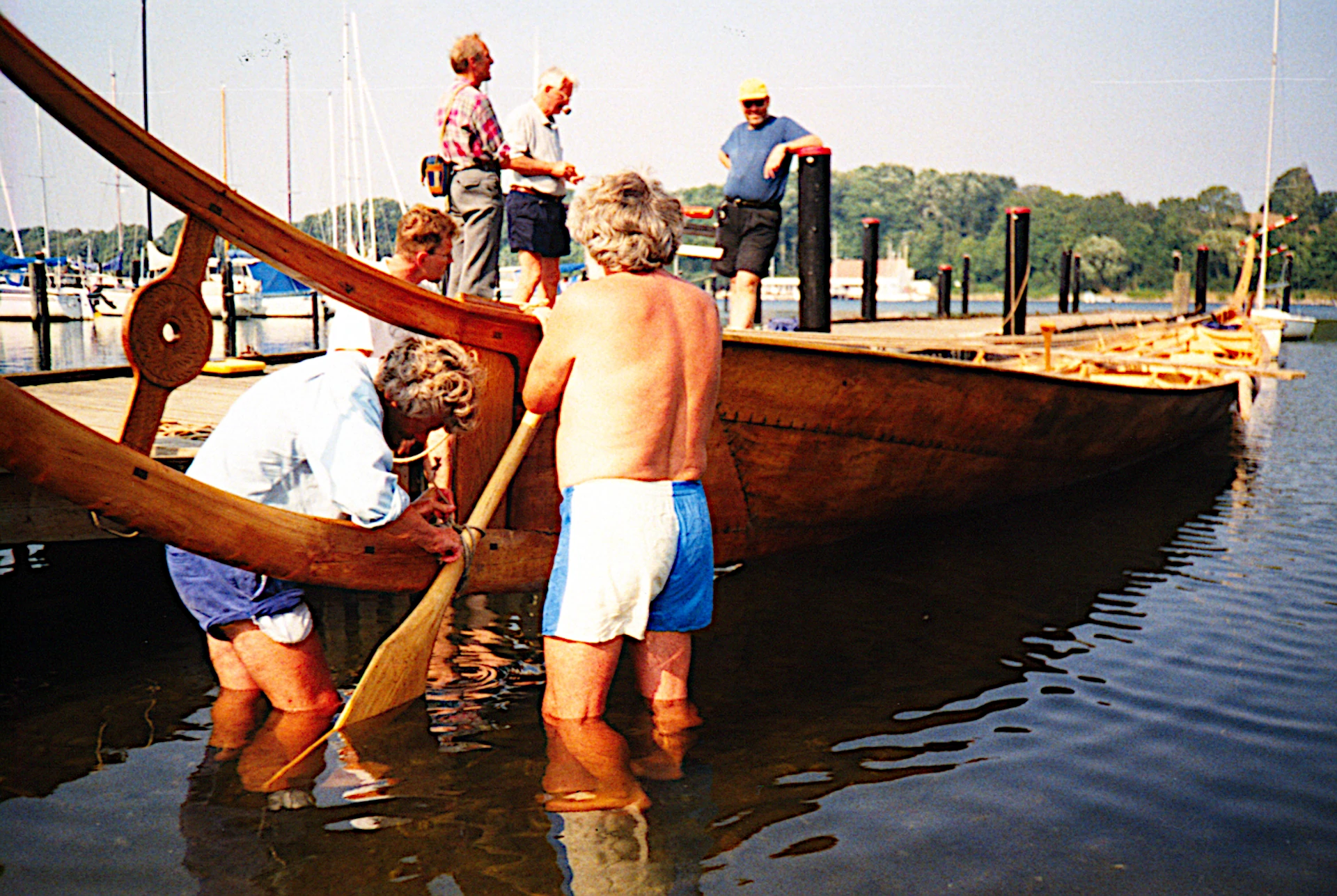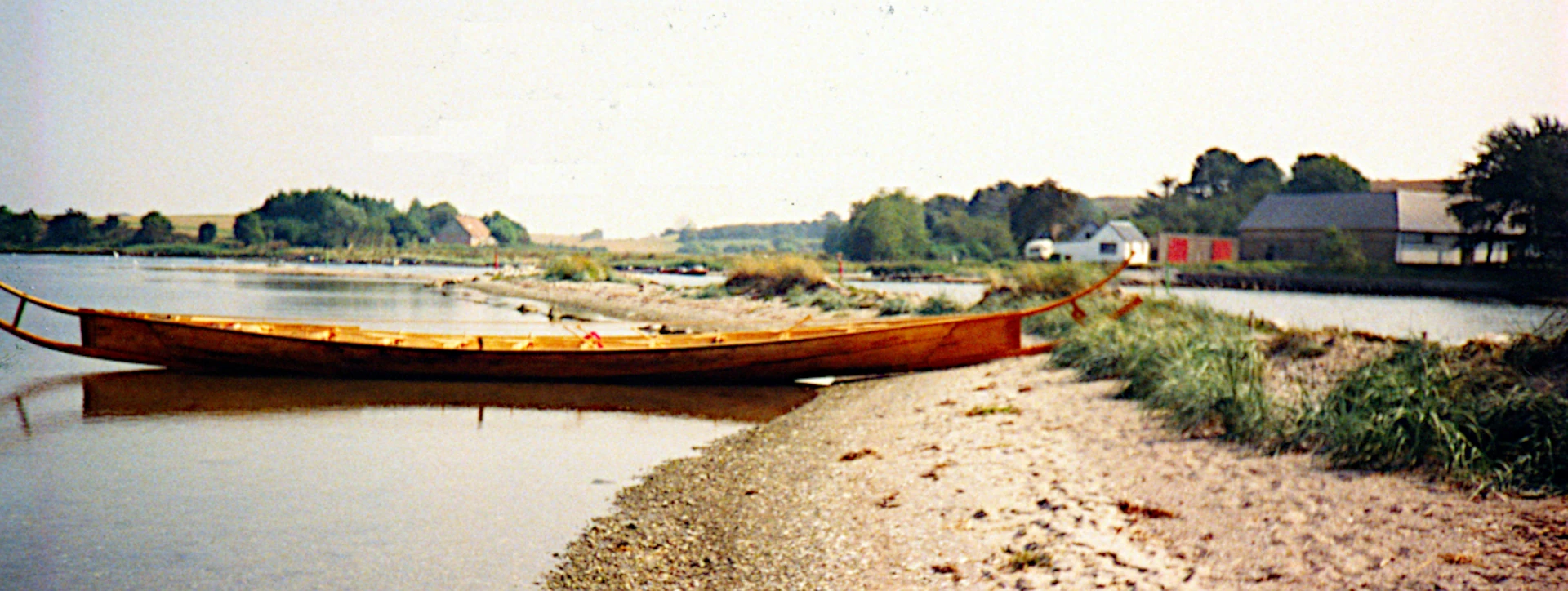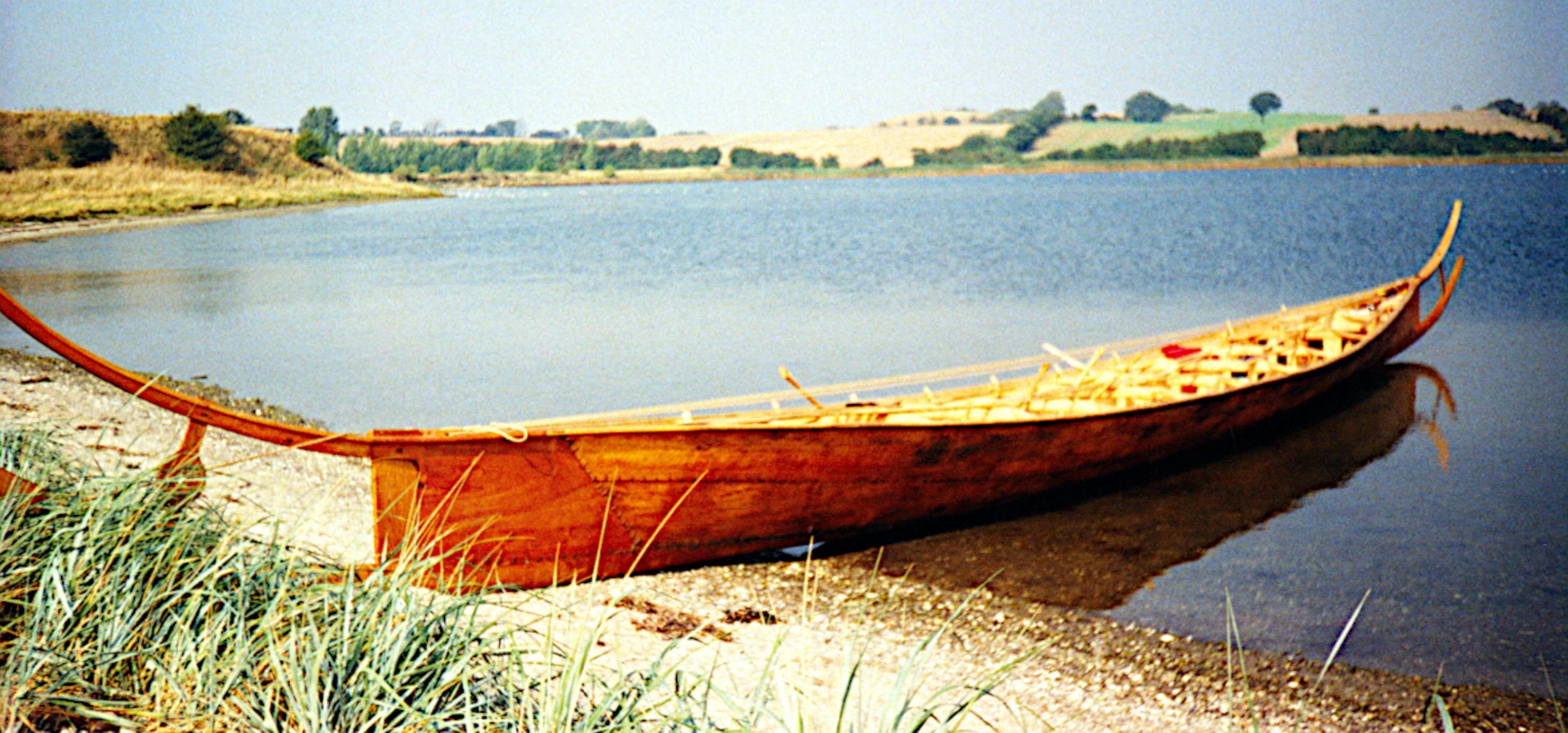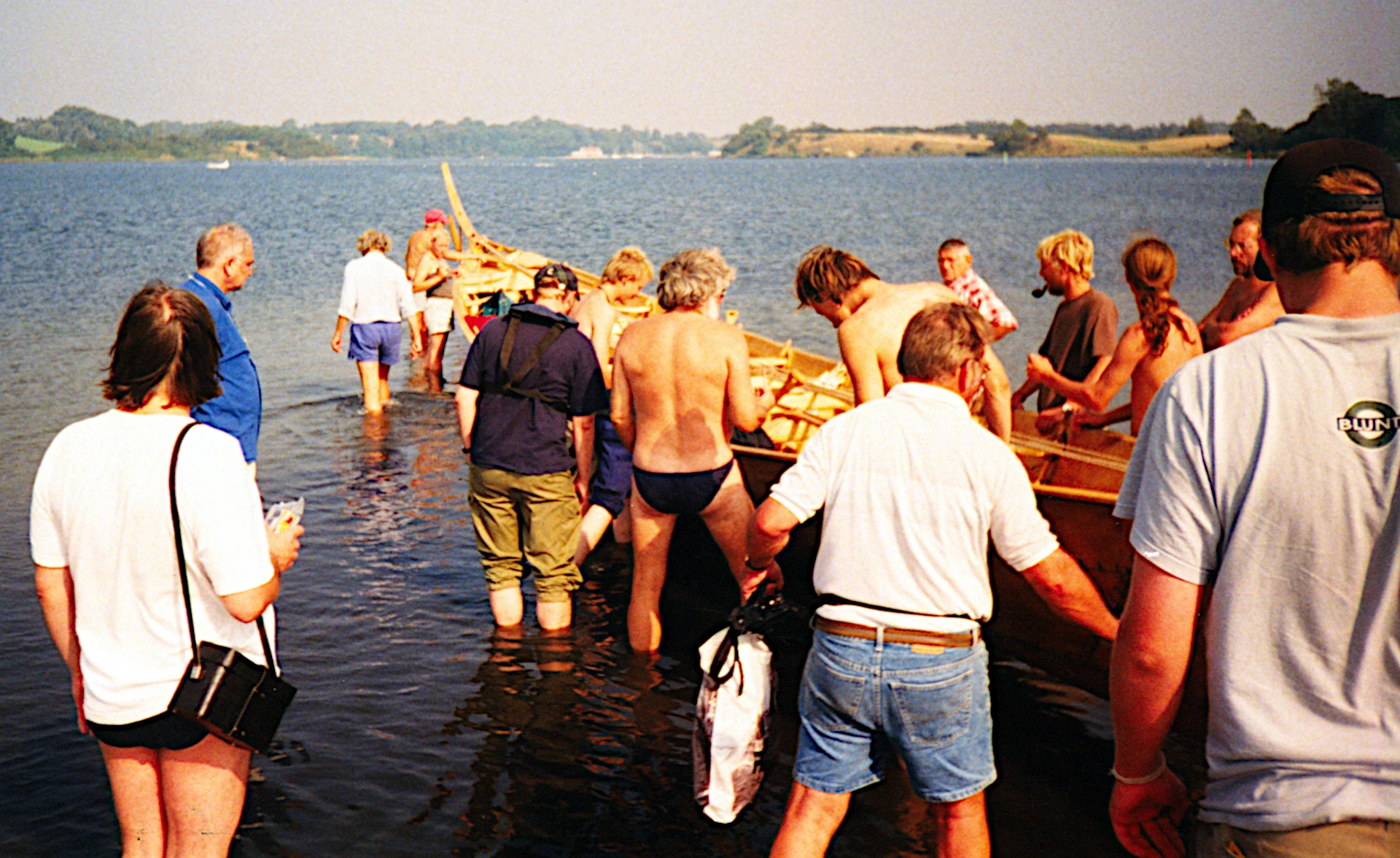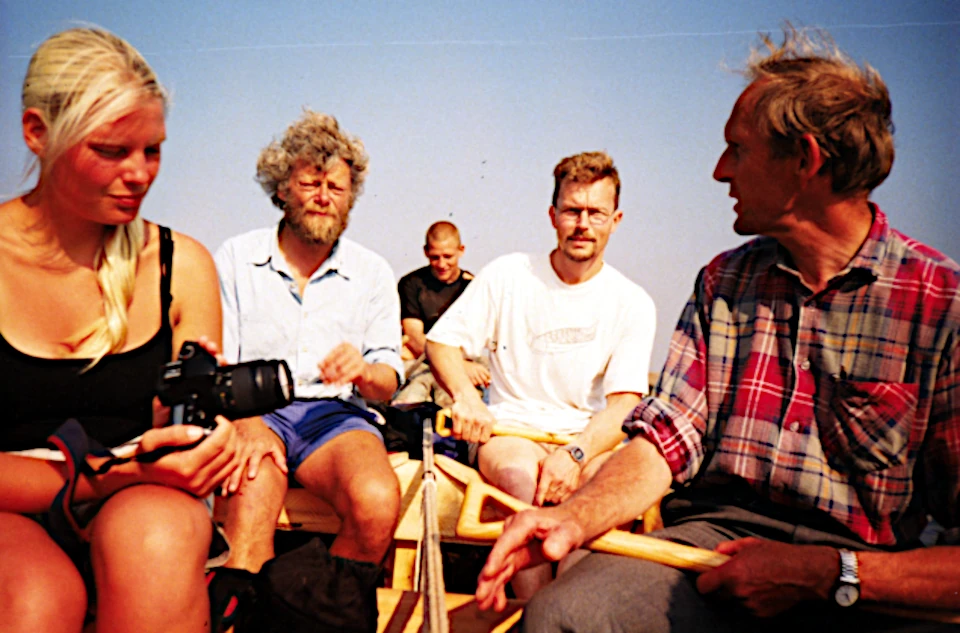Rudder positioning
Even before the Gudenå trip, we had contacted the National Museum's Marine Archaeological Research (NMF) to see if they could help us with a more powerful crew. In September 1999, Max Vinner, head of the Viking Museum's training centre in Roskilde, arrived with 8 young students from the training centre and 4 employees from the museum's training and school service, all used to rowing Viking ships. We then had to supplement with some of our most vital members.
From the start of the series of trials, it was recognised that the crew still lacked the paddling experience that our predecessors would have been expected to have had. The purpose of the trials was to outline the available options, solve some practical problems with the handling and manoeuvring of the boat, and from there outline a test plan for the coming years with a professional crew of paddlers.
It was three very exciting days where we learnt a lot about the boat's capabilities.
One important realisation was that Tilia was very unstable directionally. This made it very difficult to steer the boat with the position we had given the steering oar. Unfortunately, the discovery of the original Hjortspring boat had no indication of where and how to attach the steering oar.
In order to lengthen the waterline and make the boat more directionally stable, all trials were sailed with a midship ballast of sandbags with a total weight of 600kg. However, steering behaviour was not noticeably improved with the specified ballast.
Trials were conducted with two steering oars, one on the starboard and one on the port side. This did not provide any significant improvement either.
This new position provided convincingly good steering performance. Depending somewhat on wind speed and direction, the boat could be turned 180 degrees in one minute at a good speed with a turning diameter of 35-40 metres. As the discovery of the boat had identified two steering veins, one at each end of the boat, steering trials were carried out with two steering veins, the first attached to the bow horn and the second to the stern horn. Both steering oars were positioned almost vertically. With these two, the steering was overwhelmingly good.
Even in windy conditions (6-8 m/s), the boat could be turned 180 degrees in half a minute with a turning diameter of 30 metres. In calm weather, we achieved a turning diameter of 20 metres, still in ½ minute.
Even steering with only the stern oar in use could be used with excellent results. Sailing through the entrance to Mjels Vig, a somewhat crooked and narrow course, was fine with the stern thwart alone. In short, there was no significant difference between using the stern oar and the bow oar in terms of steering.
Turns using the paddles alone without using the steering oars, i.e. shod on one side and paddled on the other, stopped the boat and it turned around its own vertical centre axis.
Speeds
The boat could be accelerated from zero to 5 knots in about ½ minute. For braking from 5 knots to zero, only 5 seconds were needed over three quarters of the boat length when the crew shuttered heavily.
The long horns made it difficult to dock, so sideways movement proved necessary. This was done by pulling the paddles across towards the freeboard on one side of the boat and pushing them away from the freeboard on the other side.
A series of speed trials were conducted over a course of 1,160 metres (or 0.63 nautical miles). All trials were conducted with a flying start and with 16 paddlers in action. The wind had a speed of 4-5 m/s and a direction of less than 45 degrees to the course. All these trials were conducted with 600kg of ballast, so the total displacement (weight) of the Tilia was 3,000kg. We list some typical results here:
| Paddling stroke | Wind at an angle: | Average speed |
| 38 / minute | From front | 4.0 knots |
| 38 / minute | From the back | 4,3 knots |
| 48 / minute | From front | 4,5 knots |
| 48 / minute | From the back | 5,1 knots |
This final speed of 5.1 knots was the highest measured during the test series.
Stability
For stability, we quote from Max Vinner's report:
Empty, the Hjortspring replica seems very unstable. It's unsafe to move around in it, especially as there are no proper floorboards etc. to step on. With the whole crew, things are immediately better, even though the crew's centre of gravity is somewhat higher than the boat's. Compared to the classic sailing vessels we are familiar with, such as Viking ships, the initial stability seems so low in empty condition that one is not exactly tempted to call it seaworthy in this respect. It helped the feeling of security when the 600 kg was put on board, and all the sailing trials have been carried out with this ballast.
However, it must be pointed out that the feeling of dangerous instability is a feeling that is partly based on habit (Viking ships etc.). In fact, the boat did not capsize while paddling without ballast. With sufficient practice and training, an experienced crew should easily be able to tumble this boat safely without ballast, especially as it was obvious that on the last day, when the ballast was removed and the stern rudder fixed, the boat was faster and more manoeuvrable when it was rowed to the slipway in Dyvig where it was to be taken ashore. Perhaps the rhythm of the paddling and the boat's speed in the water can contribute to its stability? And maybe the ‘rocking’ caused by the instability can actually benefit the paddlers' rhythm and thus speed?
Some stability measurements were taken of the boat lying alongside the quay. A towing test was also carried out in which Tilia was towed by a motorised dinghy so that coherent values between towing force (=resistance) and speed could be obtained. The tests failed because the dinghy repeatedly cut out and disrupted the readings.
Conclusion
- The almost vertical position of the steering vein, lashed to the root of the keel horn, seemed convincing
- The boat is very manoeuvrable in terms of acceleration, braking and turning
- With a young but untrained crew, the boat could reach a top speed of 5 knots, while a cruising speed would be 4 knots
- Stability feels poor, but in practice, when the boat is sailing, it is sufficient to avoid ballasting
- Testing should be repeated, this time with highly trained paddlers, both to establish the top speed and to assess how far the boat can travel in a day
A number of trips were made around the Dyvig/Mels Vig area. This included a landing on the sandy beach at Stegs Gab. The crew was joined by museum curator Flemming Kaul from the National Museum of Denmark and Professor Klaus Randsborg from the University of Copenhagen. The two gentlemen had studied and analysed the Hjortspring find and boat over the years, and as paddlers, they now got a first-hand impression of the boat and its characteristics.




